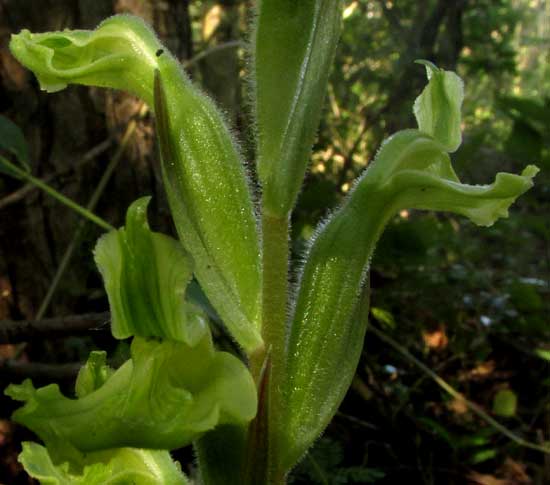Excerpts from Jim Conrad's
Naturalist Newsletter
from the January 7, 2018 Newsletter issued from Rancho Regenesis in the woods ±4kms west of Ek Balam Ruins; elevation ~40m (~130 ft), N20.876°, W88.170°; north-central Yucatán, MÉXICO
A GREEN-FLOWERED SARCOGLOTTIS ORCHID
Right beside the trail leading through the woods to the rancho, the trail that surely I've taken a hundred times so far, suddenly something new and unexpected has appeared, shown elow:

It's an orchid, one I've not seen before. Unlike most orchids, it's growing on the ground instead of on a tree. Its rosette of glossy, variegated basal leaves is striking and somewhat unusual, but it's those green flowers that demand attention. A closer look is shown below:

Anyone familiar only with the structure of typical flowers finds orchid blossom anatomy surreal. The most striking orchid innovation is the column, or "gynandrium," formed by the union of the flower's style, stigma and stamens. In the above picture, the flower at the lower, left shows the column doing something strange. It's curving downward to the point that its spreading, flat tip appears to be touching the floor of the broad "lip." A close-up of this is shown below:

I'd like to know how this construction functions, but just can't find literature explaining it. My guess is that pollinators land on the broad lip, and in trying to pass beneath the column to reach sweet-smelling nectar, somehow accomplish pollination.
In terms of evolutionary history, the Orchid Family is one of the most recently arisen families. In accordance with general evolutionary trends, the family has explosively produced an amazing diversity of species -- it's the most species-rich of all plant families -- while at the same time integrating parts. Our flower's column formed by the union of the flower's style, stigma and stamens is an example of that trend toward integration and fusion.
However the flower's curved column works, our orchid is SARCOGLOTTIS SCEPTRODES, native throughout most of Mexico's humid lowlands, and through much of Central America. It's uncommon, but not regarded as a threatened species on a national level.